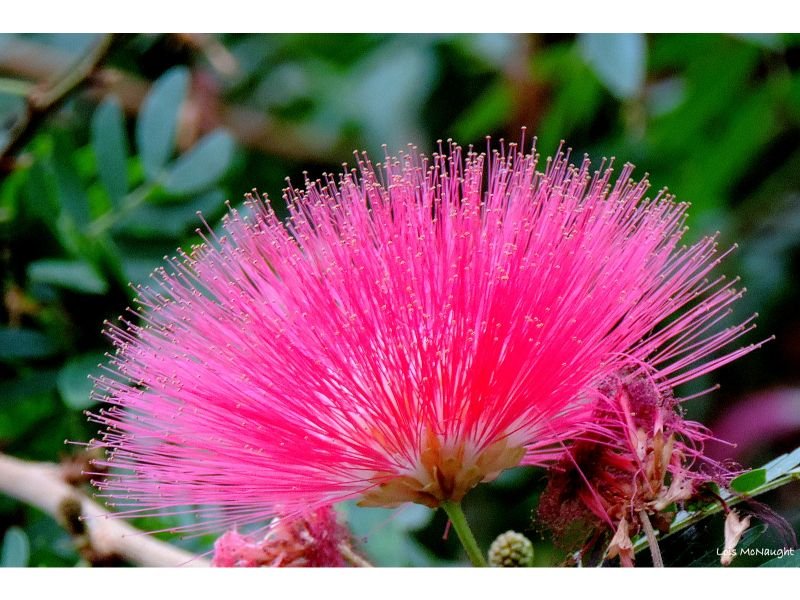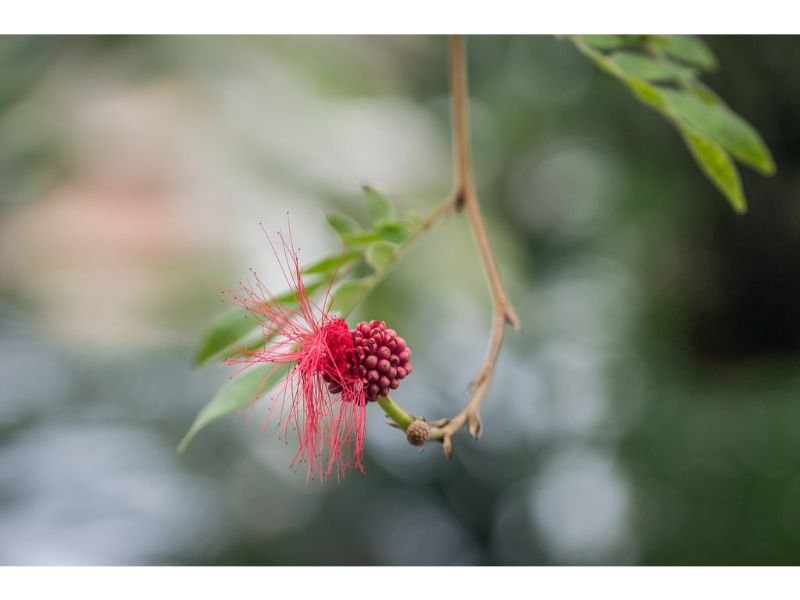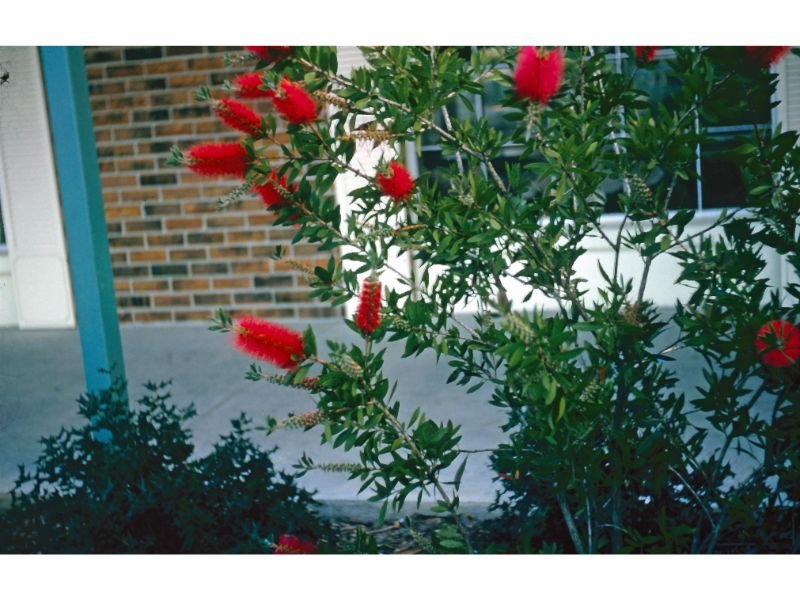If you look from afar, they look like round, fluffy cotton balls. But they’re a plant. What are they? Yes, they’re powder puff flowers!

Powder puffs are plants with a unique blooming flower shape. They’re native to tropical and humid regions of South America. With astonishing “flowers” which are made of stamens that are shaped roundly–like a fluffy powder puff, no wonder powder puff flowers are well-known amongst plant lovers as an ornamental flowering plant.
relatively easy-to-grow outdoor and indoor plants, however, there are rules you have to pay attention to care for this beautiful plant. We will show you how.
Table of Contents
Puff flower plant specifications.
Also known as Calliandra haematocephala or simply Calliandra, powder puff flowers are a type of evergreen bushy plant, which means they stay green all year round.
A little fun fact, they’re part of the Leguminosae family which consist of soybeans and chickpeas!
Aside from its powder puff-like flowers, it has dark green, double pinnate, elongated thin leaves with a size of around 5 centimeters. Powderpuff trees can grow as high as 5 meters or taller if grown outdoors, but dwarf Calliandra species grow much shorter only about 90 centimeters.

Both dwarf and common Calliandra species can be grown indoors. The flowers are fragrant and attract animals like butterflies and hummingbirds. Red is the usual flower color for this plant although other cultivars can grow colors such as magenta, purple, and white. The powder puff tree is a fast-growing plant with a shallow root system.
How to care for powder puff flowers?
Hardiness Zone and Temperature
When it comes to planting, one of the most important things is to know what your hardiness zone is. Knowing this can do wonders both for you and your plants since different hardiness zones equal different plants you can grow there.

Thus, different ways to take care of them. For the power puff plant, the hardiness zone falls into the range between 9 and 11, where the temperature is around 20 to 50 Fahrenheit. Plants that live in this hardiness zone love to be placed in warm areas where winter is mild and not extremely cold. This making powder puff plant moderately tolerates winter.
What to do if I don’t live in this hardiness zone but still want to grow powder-puff flowers?
The first thing you can do is to provide as much warmth to your puff flower plant as you can. Figure out which direction your garden and your house are heading. If it is south-facing, congratulations since this direction receive the most and the hottest sunlight. If it is not, then you can provide warmth by using tools like grow lights for plants. If the last trick is not available, then you might consider planting other plants.
Water Requirement
Red powder puff flower needs to be watered regularly during their growing season which is from spring to early summer. Stop watering when it comes to winter and autumn.
Give water to your powder puff plant about 5 to 8 centimeters thick. Keep the soil moist and water all around the plant’s part but do not let the water sit for too long in the stems part as it might retract to the leaves, causing it difficult to evaporate.
How do I know if it’s time to water my puff flower plant?
You can do a finger test. Dip your fingers into the topsoil for a while then take your fingers out. Notice if there is only a bit of soil stuck to your fingers and if your fingers feel dry, then it is absolutely the time to give your plant much water it needs.
How do I know if I give my puff flower plant too much water?
Take a look at the leaves. If it’s showing unwanted signs such as yellowing and withering, it must be a sign that you give it too much water. Also, pay attention to the stems. Overwatering plants usually have a “soft” and limp feel when you pinch the stems. To overcome this, reduce the amount of water and prune the yellowing leaves if needed.
Sunlight Requirement
Due to their natural habitat in hot tropical areas, red powder puff flowers need both full direct sunlight and partial shade. Place it under full, bright direct sunlight for 6 hours or more a day. When grown in partial shade areas, where it receives only four to two hours of direct sunlight, it won’t bloom as much as when you place it in under direct sunlight areas.
What to do if it’s winter and there is not much sun?
Generally, puff flower plants can survive winter except for the extreme, cold, and harsh winter–just like any other plant. However, if you feel the cold is intolerable, you can move the plant indoors.
If the plant has grown too large and there is nothing you can do, you can propagate and grow your red powder puff flower in a smaller container indoors. They are easy to propagate anyway.
Could extreme hot weather make my powder puff flowers die?
Yes, anything too much is not good for your plant, including too much heat. It can lead to heat damage. One easy way to recognize it is by looking at the leaves. It would feel “crispy”, turn brown, and start to shed. To fix this issue, cut the brown and dead leaves, remove your plant to a colder area, and give it more water to rehydrate the plant.
Soil Requirement
Red powder puff flower cultivars love soil that is rich in nutrients, well-draining and has good aeration. For soil mix, you can use coco peat moss and perlite along with an all-purpose soil mix. Keep the pH slightly acidic to a scale of 6.0 to 7.1. Planting and repotting should be done in spring or early fall when it’s actively growing.
Are puff flower plants prone to root bound?
Yes, since they’re fast growing and can grow aggressively so you must pay attention regularly to its root. If there’s a root bound, you can separate the roots by finger carefully.
Another thing you have to check is the pot or container size. The bigger the plant grows, the more roots will also expand wider. If the growing pot is too small, it will be more prone to root bind.
After separating the roots, you have to move the plant into a bigger pot or container and add a new soil mix as well. You might need a new planting medium for this.
What can I do to promote powder puff flower growth?
Fertilizer can be very beneficial to promote the health and growth of your powder puff flowers. You can use both natural and chemical fertilizers. If you go by nature, you can use materials like compost made from kitchen waste or banana peel, crushed eggshells, grounded coffee, bone meal, fish meal, or alfalfa.
For chemical fertilizer, you can use the two main parts of fertilizers which are phosphorus and potassium. Scatter this fertilizer around the topsoil. Remember not to over-fertilize and limit the usage of the fertilizer only when it’s their growing phase.
Take note: Powder puff plant can produce their nitrogen so avoid using nitrogen as a fertilizer since it can promote pests and make the plant grow competitively.
What will happen if you over-fertilize your puff flower plant?
It can lead to problems such as unwanted growth spurt, root bind, making the plant weaker since it will “fight” to get more nutrients for the newly sprouted seeds, leaf drop, yellowing or browning leaves, as well as making it more vulnerable to pests and diseases.
Humidity and Propagation
Red powder puff flower is best grown in areas with moderately high to high humidity. Propagation can be done by using stem cutting. Here’s how:
- Choose a dark green, matured stem with a minimum of 1 centimeter in diameter
- Cut the stem into a pointed shape around 10 to 15 centimeters long
- Prepare the container or pot that filled already with nutrient-rich soil mix
- Place the stem in the soil mix in an upright position and water regularly
- If the roots have grown well, you can mix the plant into their final planting area
Overall, powder puff plants need wide space and bigger containers but they can be trimmed down to narrow the space. If you’d like a smaller plant and can’t provide as much space, you can plant the dwarf species of powder puff flowers or do this propagation so it can promote new growth in a much smaller area.
How do I provide my powder puff flowers with more humidity?
To provide more humidity, the first thing you can do is to move your plant to an area where humidity is high. For example, the bathroom. Second, you can also use the help of a humidifier. Finally, you can use a spray mist of water on your plant to give it more humidity without causing over-watering.
Common red powder puff flower pests and diseases.
Common pests of this plant include aphids, mealybugs, spider mites, gnats, and flea beetles. These pests usually suck the sap out of your powder puff plants in areas like stems, leaves, and newly grown stems.

Common diseases include yellowing and withering leaves, browning leaves, leaves spots, stunted growth, stem and root rot, no new flowers, and plants growing in the wrong direction. For example, it grows where the sunlight comes the most.
Human error, bacteria, fungi, as well as viruses can cause diseases for your red powder puff flower with the same symptoms as previously described. Depending on what kind of micro-organisms or pests caused your plant’s diseases, in some cases, you might have to completely isolate your plant to prevent transmission to another nearest plant.
How do I get rid of pests from my powder puff flowers?
First, wipe the infected area with a damp cloth or use water to sanitize your plant a bit.
Remove the leaves or stems if it gets too infected. While doing this process, be cautious since viruses, bacteria, fungi, and pests spread through the splashing water.
Next, you can use neem oil or insecticide and spray it regularly on the affected areas. Materials like dish soap, vegetable oil, and vinegar can do the trick too.
However, in some more serious cases like infection by fungi and deadly plant viruses like the Tobacco mosaic virus, the plant will be infected for most of its life.
How do I get rid of diseases from my red powder puff flower?
The first thing you have to inspect is to find what causes your plant’s disease. Is it because of human error like over-watering or is it because of pests, fungi, and bacteria?
You should be able to distinguish the causes because most of the time, for example, diseases that are caused by over-watering and mealy bugs, both will cause the leaves to turn yellow. But they require a different treatment.
Once you find the root of your problem, you can start treating the plant based on what caused its diseases. Another illustration is if your powder puff flowers stunted growth caused by over-fertilizing, you have to decrease the amount of fertilizer or stop giving the plant fertilizer for a while.
But if it’s because of pests like aphids and spider mites, you can get rid of it by using insecticide or neem oil.
The use of puff flower plants.

Besides its gorgeous shape and ease of maintenance, there are many things you can do with powder puff flowers.
First, of course, it can add beauty to your house or garden. Whether your garden theme is casual, sunny-look, vintage-look, fairy, and fantasy-themed, or pollinator garden-themed, this flower can be a perfect addition to your garden. Puff flower plants can also be grown as hanging plants for your window box garden.
You can also pick some blooming puff flower plants and add them to your flower bouquet, or simply give the flower as a gift for your loved ones.
Keep in mind that there’s no scientific use for this flower so it’s best to avoid consuming it.
Wrap up.
In general, powder puff flowers are unique and easy-to-grow plants that can be grown whether you are a novice or a top chief in the gardening world. They produce round, powder puff-like flowers that grab anyone’s attention by simply just looking at them. If you wanna know more about gardening, don’t forget to check other articles to give you free, accurate, and useful tips. Happy Gardening!

New author in the hood. Loves gardening and flowers are my spirit animals (yes I know they are not animals but I insist). I will be covering most of the flowers’ topics here and occasionally random though as well.






